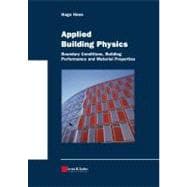
Note: Supplemental materials are not guaranteed with Rental or Used book purchases.
Purchase Benefits
Looking to rent a book? Rent Applied Building Physics : Boundary Conditions, Building Performance and Material Properties [ISBN: 9783433029626] for the semester, quarter, and short term or search our site for other textbooks by Hens, Hugo S. L. C.. Renting a textbook can save you up to 90% from the cost of buying.
| Preface | |
| Introduction | |
| Outdoor And Indoor Conditions | |
| Overview | |
| Outdoor Conditions | |
| Dry bulb (or air) temperature | |
| Solar radiation | |
| Long wave radiation | |
| Relative humidity and (partial water) vapour pressure | |
| Wind | |
| Precipitation and wind driven rain | |
| Standardized outside climate values | |
| Indoor conditions | |
| Dry bulb (or air) temperature | |
| Relative humidity and (partial water) vapour pressure | |
| Water vapour release indoors | |
| Indoor climate classes | |
| Indoor/outdoor air pressure differentials | |
| Performance Metrics And Arrays | |
| Definitions | |
| Functional demands | |
| Performance requirements | |
| Some history | |
| Performance arrays | |
| Functionality | |
| Structural adequacy | |
| Building physics related quality | |
| Fire safety | |
| Durability | |
| Maintenance | |
| Costs | |
| Functional Requirements And Performances At The Building Level | |
| Thermal comfort | |
| Physiological basis | |
| Global steady state thermal comfort | |
| Local discomfort | |
| Transient conditions | |
| Comfort related enclosure performance | |
| Health and indoor environmental quality | |
| Energy efficiency | |
| Energy use in buildings | |
| Space heating | |
| Parameters defining the net energy demand for heating | |
| Net energy demand for cooling | |
| Gross energy demand, end energy use | |
| Buildings ranked in terms of energy efficiency | |
| Durability | |
| Life cycle costs | |
| Sustainability | |
| Heat-Air-Moisture Performances At The Envelope Level | |
| Air-tightness | |
| Thermal transmittance | |
| Transient thermal response | |
| Moisture tolerance | |
| Thermal bridges | |
| Contact coefficient | |
| Hygro-thermal stress and strain | |
| Example of a performance control: timber framed walls | |
| Heat-Air-Moisture Material Properties | |
| Dry air and water | |
| Building, insulating and finishing materials | |
| References And Literature | |
| Table of Contents provided by Publisher. All Rights Reserved. |
The New copy of this book will include any supplemental materials advertised. Please check the title of the book to determine if it should include any access cards, study guides, lab manuals, CDs, etc.
The Used, Rental and eBook copies of this book are not guaranteed to include any supplemental materials. Typically, only the book itself is included. This is true even if the title states it includes any access cards, study guides, lab manuals, CDs, etc.